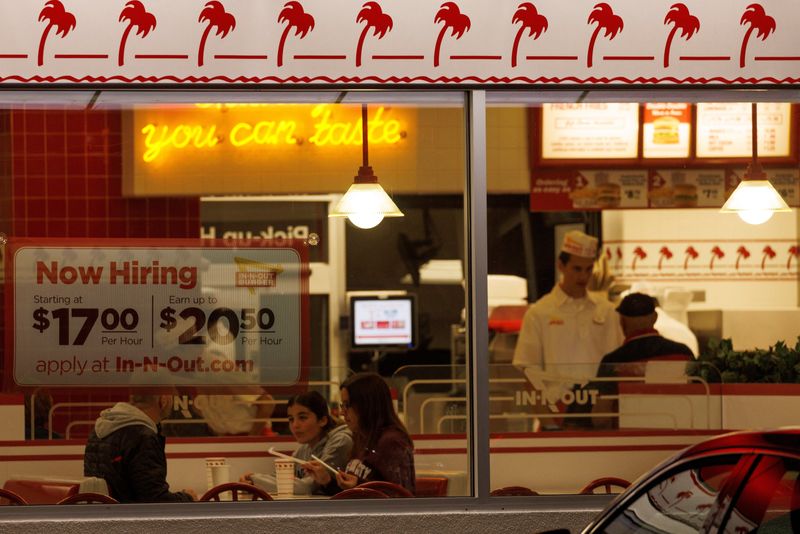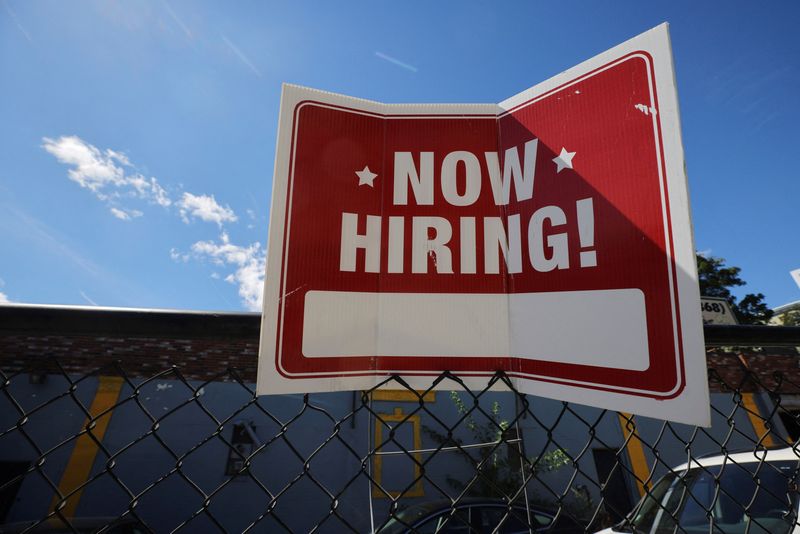By Lucia Mutikani
WASHINGTON (Reuters) - U.S. employers hired more workers than expected in August, but moderate wage growth and a rise in the unemployment rate to 3.7% suggested the labor market was starting to loosen, raising cautious optimism that the Federal Reserve could slow the economy without triggering a recession.
The Labor Department's closely watched employment report on Friday, which also showed 107,000 fewer jobs created in June and July than initially estimated, did not decisively settle the debate on whether the U.S. central bank would deliver a third 75 basis point or half-a-percentage point rate hike at its policy meeting this month.
The increase in the unemployment rate to a six-month high came as nearly 800,000 people entered the labor market, driving the size of the labor force to a record high. The labor market remains strong, underscoring the economy's resilience despite gross domestic product contracting in the first half of 2022.
"The increase in employment offers yet another rebuttal to the idea that the economy is already in recession," said Michael Feroli, chief U.S. economist at JPMorgan (NYSE:JPM) in New York. "The report keeps alive the hope that a soft landing is still a possibility."
The survey of establishments showed nonfarm payrolls increased by 315,000 jobs last month, after surging 526,000 in July. August marked the 20th straight month of job growth. Employment is now 240,000 jobs above its pre-pandemic level.
Economists polled by Reuters had forecast payrolls increasing 300,000, with estimates ranging from as low as 75,000 to as high as 450,000.
Some economists cautioned against reading too much into August's slowdown in payrolls growth noting that the response rate to the establishment survey last month was the lowest since 2006. Response rates have been historically lower in August because that is when most Americans take their summer break.
There has been a tendency for the initial August payrolls counts to be revised significantly higher.
"Over the past five years the average upward revision between the first and third estimates is nearly 120,000," said Ryan Sweet, a senior economist at Moody's (NYSE:MCO) Analytics in West Chester, Pennsylvania. "Therefore, job growth in August could be stronger than it first appears."
The broad increase in hiring last month was led by the professional and business services industry, which added 68,000 jobs. Healthcare payrolls increased by 48,000 jobs.
Employment in the retail trade sector rose by 44,000 jobs, while manufacturing added 22,000 positions. Construction employment rose by 16,000 jobs.
Leisure and hospitality payrolls increased by 31,000, a step down from an average of 90,000 per month in the first seven months of the year. Employment in the leisure and hospitality industry remains 1.2 million jobs below its pre-pandemic level.
Fed Chair Jerome Powell last week warned Americans of a painful period of slow economic growth and possibly rising unemployment as the central bank aggressively tightens monetary policy to quell inflation.
The Fed has twice raised its policy rate by three-quarters of a percentage point, in June and July. Since March, it has lifted that rate from near zero to its current range of 2.25% to 2.50%. Financial markets are pricing a roughly 58.0% probability of a 75 basis points increase at the Fed's Sept. 20-21 policy meeting, according to CME's FedWatch Tool. That is down from 70% before the release of the employment report.
August consumer price data due mid-month will also be a major factor in determining the size of the next rate increase.
Stocks on Wall Street were trading higher. The dollar fell against a basket of currencies. U.S. Treasury prices rose.
LABOR FORCE RISES
While the unemployment rate increased to 3.7% from a pre-pandemic low of 3.5% in July, that was because 786,000 people entered the labor force. The biggest increase since January pushed to workforce size to an all-time high, topping the previous record in December 2019.
As a result, the labor force participation rate, or the proportion of working-age Americans who have a job or are looking for one increased to 62.4% from 62.1% in July. It remains one percentage point below its pre-pandemic level.
The rising labor pool, if sustained, would help to narrow the gap between supply and demand for workers. There were 11.2 million job openings on the last day of July, with two job openings for every unemployed person.
"This is a pressure release valve that could help the Fed accomplish its task of bringing down inflation and achieving a soft landing," said Yung-Yu Ma, chief investment strategist at BMO Wealth Management in Dallas.
But some economists are skeptical that the labor pool will continue expanding, noting that August's surge was driven by seasonal factors as well as rising participation by prime-age workers.
The participation rate for this cohort is now higher than the average rate for 2019.
"We would expect the downward trend in the unemployment rate to resume in September," said Conrad DeQuadros, senior economic advisor at Brean Capital in New York.
Wage growth cooled, with average hourly earnings rising 0.3% after increasing 0.5% in July. That left the annual increase in wages at 5.2% in August. Strong wage gains are keeping the income side of the economic growth ledger expanding, though at a moderate pace, and a recession at bay for now.

The average workweek dipped to 34.5 hours from 34.6 hours in July, a potential sign that businesses are starting to reduce hours because of the economic uncertainty.
The number of people working part-time for economic reasons increased to 4.1 million from 3.9 million in July.
